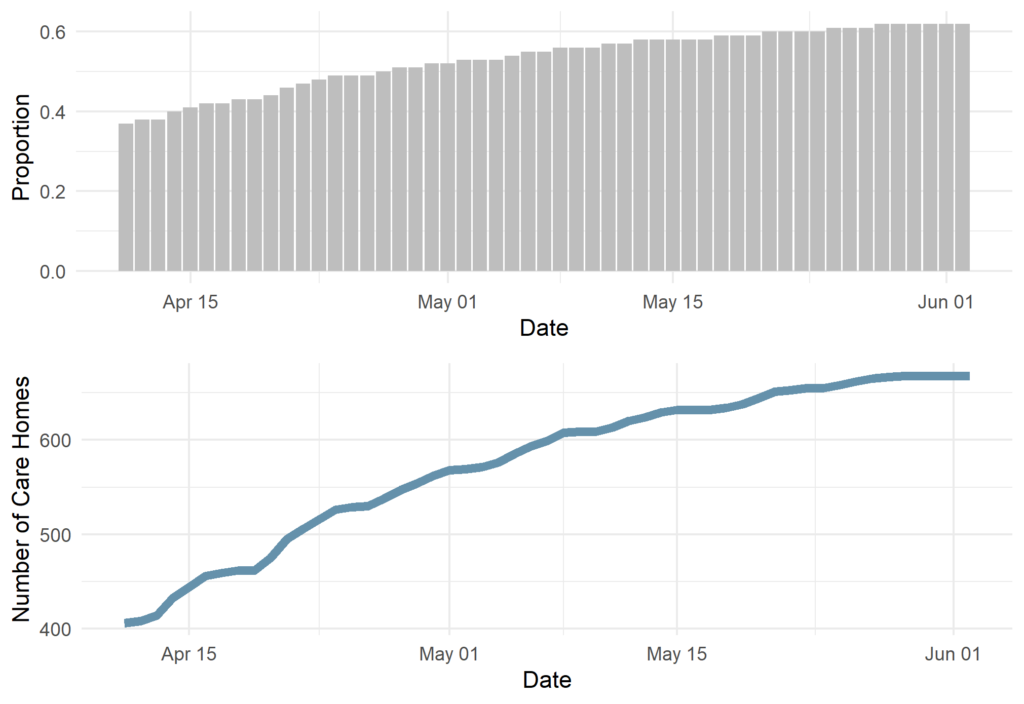The COVID-19 pandemic has had a devastating impact worldwide. Throughout the world, this impact has been felt especially in the long term care (LTC) sector. Edinburgh Health Economics (EHE) Research Fellow Elizabeth Lemmon has been working with colleagues from Scotland and the rest of the UK, on several pieces of work investigating the impact of COVID-19 on care home residents.
On 14th December, Elizabeth presented at a LTC-COVID-19 webinar with Professor David Bell, on the impact of the pandemic on mortality in Scotland’s care homes up until now. In this post, Elizabeth summarizes this presentation.
I’ve been working on some bits of COVID-19 research within the LTC setting since the beginning of the pandemic. The first piece of work was the Scotland report which is available on the LTC-COVID-19 website here. Next was the UK report, in which we compared experiences across the UK during the first wave. I’ve also helped produce the LTC-COVID-19 international report on mortality in care homes. Since then, like many other countries, Scotland has experienced a second wave of COVID-19 cases.
Before I go on to describe the mortality figures in Scotland, I think it is important to acknowledge the individuals who sit behind each of the figures. That is, individuals who have lost their lives, staff who have cared for them and families who have lost people who they love to this dreadful virus.

In total, as of the 6th December, there have been 5,868 confirmed or suspected COVID-19 deaths in Scotland. Of those, 2,393 occurred within care homes. That’s around 41% of all COVID-19 deaths. The chart here shows weekly COVID-19 deaths in care homes and weekly deaths from other causes in care homes. What we can see is the differing magnitudes between the first and second waves. Clearly, the magnitude of the second wave is much smaller, but nonetheless there is a visible increase in deaths during this period.

It is important to mention that these deaths do not include those care home residents who died outwith care homes. The data available in Scotland show that throughout the pandemic, there were at least 2,686 deaths of care home residents. That takes the total percentage of COVID-19 deaths accounted for by care home residents to 46%.There is a noticeable difference in this figure between the first part of the pandemic (16th March 2020 to 28th June 2020) and the second part (29th June – 6th December). In the former, this figure was 50% and in the latter it was 35%. This change might reflect that via the implementation of new guidance and policies, we have been able to partly protect care home residents during the second wave. These include more comprehensive testing strategies, which routinely test staff and residents.

Of course, these figures are conditional on the accurate recording of cause of death, which is a relatively strong assumption. Another way to measure the impact of COVID-19 on mortality is to look at excess deaths, that is the number of deaths over and above what would normally be expected. We define excess deaths as the percentage change in deaths compared to the previous 5-year average. In the peak of the pandemic, during week 17, excess deaths in care homes were 178% higher compared to the previous 5-year average. Throughout the pandemic overall, deaths in care homes were 25% higher. It is worth pointing out that recent evidence from the Lothian region of Scotland has found that among those homes where there was no outbreak of COVID-19, there were few non-COVID-19 related excess deaths (Burton et al, 2020).

Overall, like many countries, the impact of COVID-19 in care homes has been devastating. Some of the difficulties faced by the sector from the beginning of the pandemic included a focus from government of protecting the NHS. This meant that guidance and policies for care homes on testing and PPE were slower to respond. At the same time, a large number of older patients were discharged from hospital and into care homes during the first wave of the pandemic. Having said that, recent evidence from Public Health Scotland has demonstrated that these discharges had no significant impact on the likelihood of a care home outbreak.
The pandemic has exposed the urgent need for better LTC data in Scotland, even on a very fundamental level such as who lives in Scotland’s care homes. The pandemic has spurred on huge efforts to improve administrative data collection within the social care setting, especially those in care homes.
Whilst the focus of COVID-19 within the LTC setting has been on care homes, little attention has been paid to those older people who receive care within their own homes. In Scotland, around 47,000 people aged 65+ receive free personal care within their own homes (compared to around 36,000 adult care home residents) (Bell et al, 2020). At present, we know that their care has been adversely affected by the pandemic (Care Inspectorate, September 2020), but we know virtually nothing about how the pandemic has affected their outcomes. This presents a huge gap in our understanding of how COVID-19 has affected those in receipt of domiciliary care services at home. Evidence from England suggests that the proportional increase in deaths in the home care setting exceeds that of the care home setting (Hodgson et al, 2020). Again, better administrative data on those receiving care at home might help to address this gap in Scotland.
However, administrative data can only go so far as to truly explaining the devastating impact COVID-19 has had on so many lives. In order to provide this understanding, for example the impact on unpaid carers, families, front-line workers and more, survey data is required.
The data used to produce the figures shown in this blog come from: National Records of Scotland (NRS) deaths involving coronavirus, Scottish Government Coronavirus deaths reported to the Care Inspectorate Scotland and an ad-hoc release by NRS on deaths of care home residents up until the 3rd June 2020.



